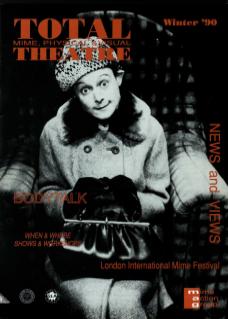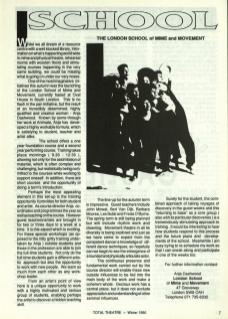Whilst we all dream of a resource centre with a well-stocked library, information on what’s happening worldwide in mime and physical theatre, rehearsal rooms with wooden floors and stimulating courses happening in the very same building, we could be missing what is going on under our very noses.
One of the most imaginative initiatives this autumn was the launching of the London School of Mime and Movement, currently based at Oval House in South London. This is no flash in the pan initiative, but the result of an incredibly determined, highly qualified and creative women – Anja Dashwood. Known by some through her work at Animate, Anja has developed a highly workable formula, which is satisfying to student, teacher and artist alike.
The school offers a one-year foundation course and a second-year performing course. Training takes place mornings (9:30 - 12:30), allowing not only for the assimilation of material, which is often complex and challenging, but realistically being committed to the courses while working to support oneself. In addition, there are short courses and the opportunity of doing a term’s introduction.
Perhaps the most appealing element in this set-up is the training opportunity it provides for both student and artist. As course director, Anja coordinates and programmes the year as well as teaching on the course. However guest teachers/artists are brought in for from two or three days to a week at a time. It is this aspect which is exciting. For these special workshops (as opposed to the nitty gritty training undertaken by Anja) outside students and those in the profession are able to join the full-time students. Not only do the full-time students gain a different artistic approach but also the opportunity to work with new people. We learn as much from each other as any workshop leader.
From an artist’s point of view here is a unique opportunity to work with a highly motivated and serious group of students, enabling perhaps the artist to discover a hidden teaching skill.
The line-up for the autumn term is impressive. Guest teachers include John Mowat, Bert Van Dijk, Barbara Mccrea, Les Bubb and Freda O’Byrne. The spring term is still being planned but will include rhythm work and clowning. Movement theatre in all its diversity is being explored and just as we have come to expect from the competent dancer a knowledge of different dance techniques, so hopefully can we begin to see the emergence of a rounded and physically articulate actor.
The continuous presence and fundamental work carried out by the course director will enable these new outside influences to be fed into the main body of the work and make a coherent whole. Decroux work has a central place, but it does not exclude appreciation and understanding of other seminal influences.
Surely for the student, the combined approach of taking voyages of discovery in the guest weeks and this ‘returning to base’ as a core group (also with its particular discoveries) is a tremendously stimulating approach to training. It would be interesting to hear how students respond to this process and the future plans and developments of the school. Meanwhile I am busy trying to reschedule my work so that I can sneak along and participate in one of the weeks too.

